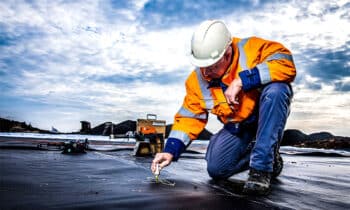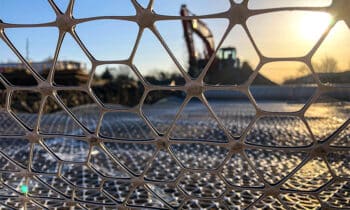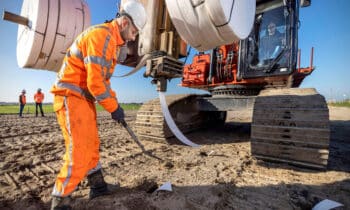
High-tech fabrics for the GWW
TenCate Geosynthetics is a company with a long history. Once begun with the manufacture of mailbags, for more than 50 years they have been producing mainly technical textiles for civil engineering, agriculture and industry, and act as a knowledge partner in civil engineering tenders. For the past three quarters of a year TenCate Geosynthetics has been operating under the wings of Solmax and in this combination has become the world market leader in geotextiles, liners and geocomposites.
Geotechnical textiles, also known as geotextiles, offer a solution to subsurface stability problems, says Marco Hazenkamp of Tencate Geosynthetics. "In essence, they provide a stiffening of the foundation structure that allows a lack of subsurface stability to be compensated. In developing our products, we aim for tensile strength at low elongation. That stiffness ensures that the supporting structure deforms less quickly and can therefore spread loads better. And something that deforms less quickly has a longer lifespan. Geotextiles such as geogrids, fabrics and composites are used, among other things, as reinforced soil construction for abutments of structures, foundation reinforcement at crane stands, for example, and as asphalt reinforcement."
At the controls yourself
TenCate Geosynthetics produces its technical textiles worldwide on various continents. A high-tech weaving mill operates in Hengelo. "We make the fabrics ourselves and that means we can turn the knobs ourselves," says Hazenkamp. The yarns from which we produce our fabrics have undergone tremendous development over the years. "We have now reached the point where we need increasingly lighter yarns by weight to achieve a certain tensile strength/stiffness. In other words, we are continuously downsizing to optimize the weight of the final product in relation to the technical specification. We also see this as a piece of sustainability. After all, the less raw material is needed in the production of our products, the less will have to be taken out at the end of their useful life." Don't take "soon" too literally, because the technical textiles have a lifespan of more than 100 years. On the other hand, there are also projects with a 2-year lead time.

Tenders
Fabrics, grids, nonwovens and composites, the range of TenCate Geosynthetics is quite extensive. "Recently we also had access to the rich product range of Solmax," Hazenkamp continues. "We were already working together on some fronts, but now we can work in a much more integrated way. For example, we now have Solmax's well-known HDPE liners and drainage composites as standard. We also support each other in projects." Indeed, TenCate Geosynthetics is asked by market parties to help think of a solution for a geotechnical challenge, for example. "We often arrive at a more economically interesting solution with the least possible impact on the environment and surroundings. We also regularly make the complete structural design of, for example, a construction road, crane emplacement or reinforced soil construction. As a manufacturer, we know exactly what our products are capable of and which calculation rules we have to comply with. Intensive cooperation with construction partners makes this possible."




